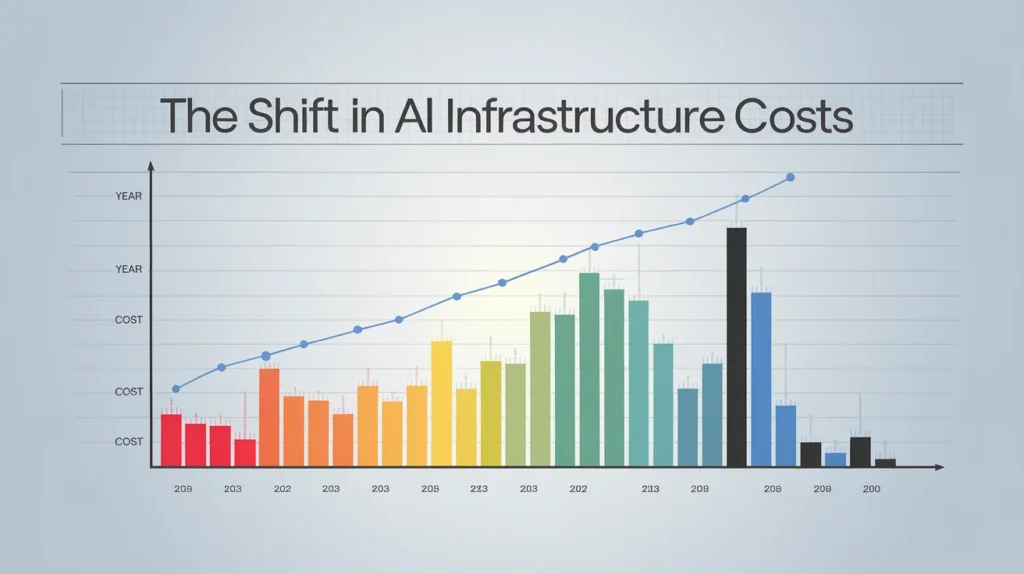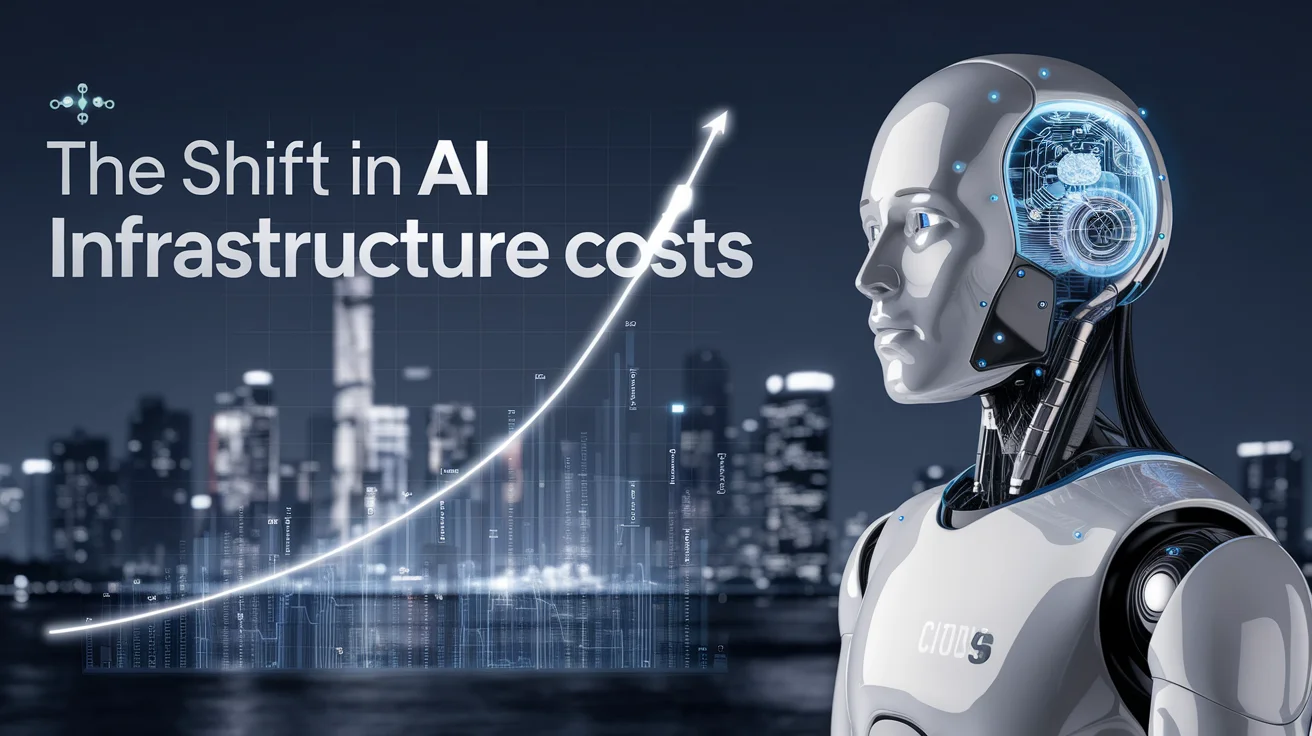In the early 2010s, AI Infrastructure Costs made AI a luxury. Only large tech companies could afford the infrastructure.
High-end GPUs, custom hardware such as TPUs (Tensor Processing Units), and vast data centers were required. But today, cloud AI providers like AWS, Google Cloud, and Azure have democratized access.
However, while access has improved, the underlying infrastructure costs have actually increased due to the explosive demand for computational power. Training models like GPT-4 or Google Gemini requires thousands of GPUs and energy-hungry data centers.
Summary: AI infrastructure is more accessible but not necessarily cheaper. As models become more complex, the costs associated with enterprises’ training custom models increase significantly.
Open-Source AI vs. Proprietary AI: Cost Comparison

The rise of open-source AI models, such as Meta’s LLaMA and Mistral AI, has brought a wave of affordability.
Businesses and developers can now fine-tune models locally or on low-cost cloud GPUs. This reduces expenses compared to relying on expensive proprietary systems like ChatGPT Enterprise or the Bard API.
Still, maintaining these models—security, updates, training—can be resource-intensive. So, the initial cost may be lower, but long-term costs remain variable depending on how you use and scale them.
Summary: Open-source AI reduces entry costs but does not eliminate operational challenges. Proprietary AI offers plug-and-play access, but at a premium.
Rising Demand for AI Talent & Services (Paragraph + Bullets)
One overlooked area affecting AI costs is the cost of skilled talent. The demand for data scientists, AI engineers, and machine learning experts is at an all-time high. Their salaries, consulting fees, and retention costs are driving up AI adoption expenses for many companies.
Moreover, companies that cannot afford in-house AI teams often rely on external vendors, which can further increase project costs.
Here’s how talent costs impact AI pricing:
- AI engineers in the US earn between $130,000 and $200,000/year
- AI consulting firms charge between $100 and $300 per hour.
- Freelance data scientists typically charge $80–$150 per hour.
- Retention costs rise due to tech competition and talent poaching.
- AI ethics and compliance specialists are adding new hiring categories.
Are AI APIs Getting Cheaper or Pricier? (Paragraph + Bullets)
Many developers build on top of AI APIs like OpenAI’s GPT-4, Google Vertex AI, or Claude by Anthropic. While these services offer quick results, their cost structure is based on token pricing, model size, and rate limits.
Smaller models like GPT-3.5 are relatively cheap, but as you shift to GPT-4 Turbo or specialized APIs, the pricing rises. Over time, more features are being introduced, but often behind a paywall.
Key cost trends in AI APIs:
- Basic APIs cost less than $0.01 per 1000 tokens
- Premium APIs (GPT-4, Claude-3) range from $0.03–$0.12 per 1000 tokens
- Image and multimodal generation APIs are more expensive.
- Enterprise licensing fees vary depending on usage tiers and support requirements.s
- Token limits and monthly caps affect scalability.
Automation and Cost Efficiency
AI is automating everything from customer support to fraud detection. This leads many to believe AI is reducing operational costs. But that’s not always true.
Deploying and maintaining AI automation tools requires an initial investment, establishing data pipelines, incurring integration costs, and establishing a monitoring team. So, while AI reduces labor costs in the long term, it often increases upfront expenses.
For example, a chatbot may replace ten support staff, but training that bot, building the backend, and ensuring it aligns with brand voice can take months and tens of thousands of dollars.
Training AI Models In-House: Expensive or Sustainable?
Training your AI model can provide you with control, accuracy, and privacy—but it’s not inexpensive. You need training datasets, compute power, machine learning pipelines, security setups, and a large DevOps team.
Big companies like Tesla, Apple, and Amazon train proprietary models internally. However, for startups or small to medium-sized businesses (SMBs), this cost can be overwhelming.
Cloud AI training options are helping bridge the gap, but they come with variable pricing and unexpected AI Infrastructure Costs related to data ingestion, storage, and iteration cycles.
Factors That Are Driving AI Costs Up (Paragraphs + Bullets)
Three major drivers are increasing AI costs:
- Compute Requirements: The larger the model, the more GPUs, RAM, and electricity it consumes.
- Data Storage & Management: As AI scales, so does your need for structured, secure, and real-time data storage.
- Regulatory Compliance: With the rise of AI governance, companies must invest in legal, compliance, and security systems to remain compliant with laws such as GDPR, HIPAA, or the AI Act.
Additional hidden costs include:
- Model drift detection systems
- Continuous fine-tuning expenses
- AI watermarking and copyright compliance tools
- Latency optimization for real-time use cases
- Bias mitigation processes
Where AI Costs Are Actually Decreasing
Despite rising prices in some areas, AI is becoming cheaper in others. For instance:
- Pre-trained models, such as DistilBERT or GPT-NeoX, reduce the need for training from scratch.
- Low-code/no-code AI platforms enable non-engineers to create AI workflows, reducing hiring costs.
- Edge AI chips allow AI to run on local devices, cutting cloud costs.
- Subscription-based AI tools provide predictable pricing.
- AI-as-a-Service models allow short-term usage without upfront capital expense.
Future Predictions: Will AI Become Cheaper or More Expensive?
Over the next 3–5 years, we can expect a mixed pattern. Basic AI tasks, such as classification, summarization, or image generation, will become cheaper due to commoditization.
However, advanced AI with real-time reasoning, long-term memory, or autonomous capabilities will remain costly due to hardware limitations and high energy consumption.
Key trends to expect:
- More open-source models will drive down pricing
- Demand for interpretability and safety will increase complexity and cost.
- Hardware innovations, such as neuromorphic chips, may reduce energy usage.
- AI chip shortages could lead to a price spike.s
- AI-as-infrastructure will emerge, offering bundled cost solutions.
Conclusion: AI Infrastructure Costs ?
To summarize, the answer to whether AI costs are increasing or decreasing is: both, depending on what part of the AI ecosystem you’re looking at. Some tools and services are becoming more affordable due to economies of scale, increased competition, and technological innovation. Meanwhile, custom model training, premium APIs, and compliance-focused AI remain expensive.
Businesses must evaluate their AI return on investment (ROI), long-term operational costs, and scalability needs to determine the best strategy for effectively integrating AI.
By staying updated with current trends and selecting the right AI approach—whether open-source, API-based, or hybrid—organizations can strike a balance between innovation and cost efficiency.
FAQ: The Shift in AI Infrastructure Costs
FAQ 1: Why is AI getting more expensive?
Answer:
AI costs more due to high GPU demand, complex models, data privacy rules, and the need for skilled experts.
FAQ 2: Will AI get cheaper for small businesses?
Answer:
Yes, open-source tools and AI services are making AI more accessible and affordable for small businesses, particularly for basic tasks.




